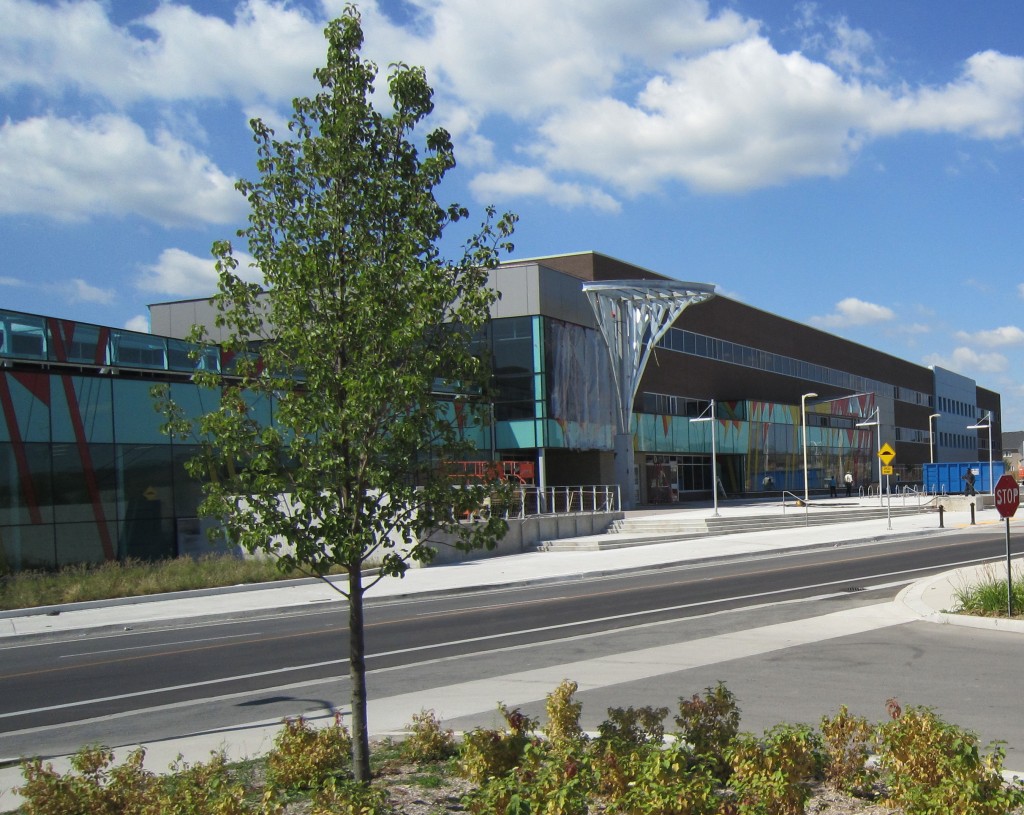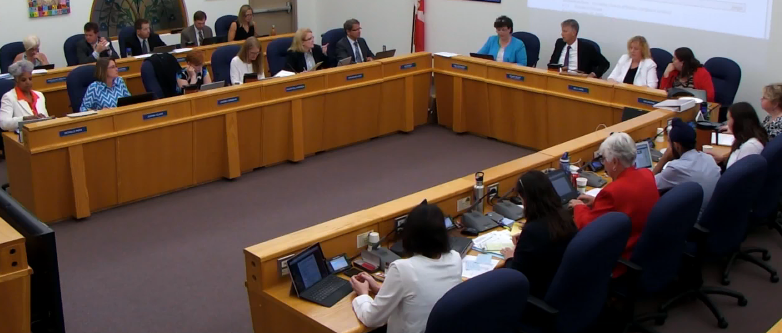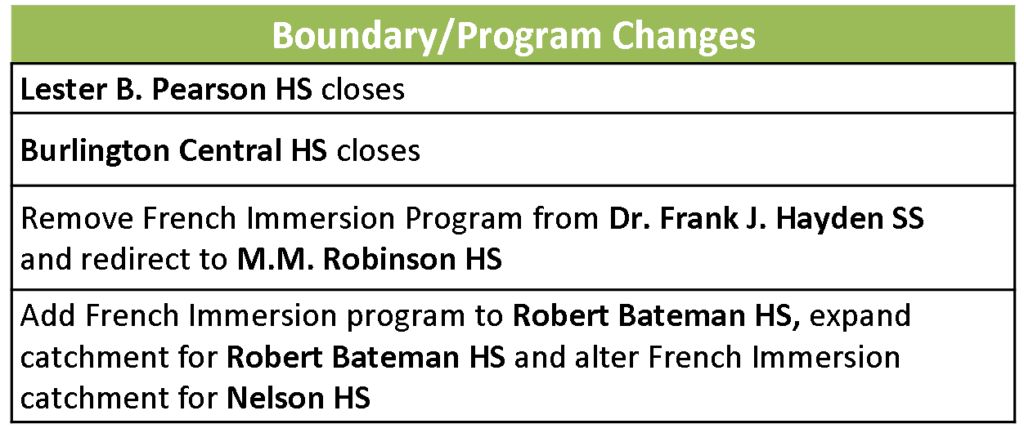January 17th, 2017
BURLINGTON, ON
Tom Muir, an Aldershot resident, has been an active participant in civic affairs. Our colleague, Joan Little described Muir as “acerbic”, a fair term for Tom.
He has outlined, in considerable length, a large part of why the parents at Central and Pearson high schools are in the mess they are in as a result of the recommendation to close their schools. There is a lot of material; it gets dense at times. Living in a democracy mans you have to accept the responsibility of citizenship and stay informed. This is a multi part story.
The Board keeps repeating the phrase – “we have too many empty seat” and that is true.
If you are asking the question “whodunnit” to us, the answer is, “the Board dunnit”. They created this awful mess and our trustees have just been sleepy collaborators in this doing.
And the Board just lets this pass by the trustees with no emphatic warning to parents, residents and city Council, of what was coming?
In my opinion, no one was in charge to see this coming and head it off, or at least give a lot of early warning, underlined and publicized.
Why you would build a new school, with projected enrollment of 1600, when the surplus of available places in the existing schools were projected to increase to 2500, and nobody says anything about this disconnection, is beyond me. Or anyone else I know who has talked about the problem, and how the Board operates.
Where is this problem going, and where might it go?
I can tell, more broadly from my study of this, that there is a lot more of this issue still underwater, and coming, but it’s understated there in the LTAP reports.
Burlington SRA 100 catchments (which can be changed, and were changed for Hayden) are in mature communities, and with the transfers to Hayden, are not projected to grow enough students to fill schools built in another era. This Burlington area is also not taking on the endless high growth of other parts of Halton.
There are new high, and elementary, schools in the pipe for this growth and the Board will be sooner or later coming for more closures to get the available place capacity down to some level to get grants for the new schools for the growth. But these new schools will be put somewhere else.
This will only cause more trouble in the future, and the suggested closures at present foretell more in the future. The elementary schools are linked, and next for PARs – stated in the current LTAP – and will be domino-ed if there are closures.
My general impression is that new schools are planned for, and built in the growth areas when grants are available. If there is too much excess students spaces elsewhere, the Board goes there, does a PAR, and takes back – closes – schools in areas with available spaces, which are in the elsewhere.
That’s like what’s being done here now, but parents and residents aren’t really being told about that part. But hints are in the LTAP reports.

Was Hayden high school needed? Was there a business case for the construction of the school. When originally planned it grew from a high school – that had a public library and a Recreation Centre added to it. There came a point when it all looked just too good. And the growing Alton community needed a high school.
There seems to be no limit to this, just the timing. It’s outrageous, and a rip-off, as we paid for the schools in the first place, and now have to pay twice for new ones – the province funds new schools with our money, then takes back some old schools, so we pay again, but with an added insult.
This is what I fought back in 1998-2000. This time, it has been hidden. You see it coming in the LTAPs, but it’s subtle.
What can Trustees do?
The Trustees of course work within the provincial rule book, but they definitely DO NOT have to choose to close schools.
They have a tool kit that they can pick and choose from so as to spread the student numbers around, together with the dollars, and innovate to keep the schools open.
However, the Board staff has chosen to make pretty much all the options presented as mostly about closures. As far as I’m concerned this is the bureaucrat in them defending their past decisions that led to this messy situation.
The Trustees have the authority to change this, and to give the Board marching orders to come up with another plan that uses all of the tool kit.

Will the 11 school board trustees hang together as a group and really think the issue through or will they leave it to the Program Accommodation Review Committee to come up with an answer they can live with.
One problem that is foreseeable is that the Trustees are played off against each other depending on the part of Halton they represent. Milton is projected to grow a great deal in population, and Oakville is next in numbers.
Milton and Oakville each have 2 elementary schools in the planning pipe for 2018 to 2021, and these are not yet funded. Each also has a high school in the planning pipe for the 2019 to 2021 period and these are not yet funded either.
These proposed schools are all for students and parents that are not even born yet, but are projected from the future growth driven by provincial orders.
This is the rub. Will the Milton and Oakville Trustees put these possible future students that are not even here yet, before existing students, already living here but in schools somewhere else – in Burlington?
Will these trustees turn against their colleagues and neighbors and vote to close their schools, so they can have some new ones for people who aren’t here yet?
People who obviously do not vote here yet, and certainly didn’t elect any of the Trustees.
The Trustees don’t have to vote that way, but who knows? People are strange.
However, they do have the power to unite and stick together. They can put together better ideas, and order the Board staff to make another plan that keeps schools open.
This will be a testing time for these trustees. Burlington Central high school is putting up quit a fight – they raised $14,000 at a Silent Auction. These people are not going to go quietly into the night.
Such a plan may contain innovative elements – which just happens to be in the latest Board Multi Year Plan goal to use innovative approaches to using learning spaces.
Part 1 of a multiple part series
























Tom
I agree the board is planning and building schools in growth areas and initiates a PAR to take back or possibly close schools in areas with excess pupil spaces.
The questions regarding funding and business cases were asked, below is the response.
“The Ministry of Education Capital Priorities Funding model, requires school Boards to submit business cases regarding the construction of new schools and additions. The business cases require the school boards to look at specific review areas/communities, such as Milton and North Oakville, in order to determine need. Under enrolled areas, such as Burlington, are not included in the analysis”
Taking this a step further, might the board be implying that if they are looking at the North Oakville community for a possible new school, they might not include South Oakville if it was under enrolled? This would not make sense to people living in South Oakville – leaving their schools partially vacant while building new schools elsewhere.
The same thinking might have been applied when scoping Hayden in North Burlington while South Burlington still had vacant student desks. If this is the case, then Mr. Muir has every reason to sound alarm bells on the board’s poor planning skills.
Building new schools in newer areas to next deplete schools in older areas, then using the depletion to justify closure sounds like a community-killing strategy at its best. And we pay these people, right?
Your final paragraph is exactly what is being done.
And you got there in the preceding paras in a similar logic train as I.
Details differ a little, but the main points are the same and correspond to what really happened.
JQ Public
I don’t know if what you are suggesting is right or wrong.
To be certain I would need to see the business case for new schools and the current information of existing schools.
Like the situation in Burlington, without the Hayden business case and school information at that time I can’t say with any certainty.
If you are right this is the time for Oakville and Milton to look at the situation, in Burlington we have to work with what is already in place.
You mention Milton and North Oakville only, but says Burlington is not included.
Is Hayden not in Burlington? It’s not in Oakville or Milton.
If so, your paragraph is not a rationale or explanation for what was done.
And at the time the Hayden plan was made – we don’t have the case study you quote as having been done at the proper time – the rest of Burlington was treated as a holding area for students for Hayden, and was a surplus of seats in waiting.
Thus, Burlington was in fact treated in the analysis, contrary to the directions you provide. It didn’t have a significant surplus at the time, but one was created by building Hayden.
Tell us what the source of you quoted paragraph is, and the full context of it.
If you don’t do this then it’s not real facts in evidence.
Tom
The question put to the board, “Is the Board reviewing the closing of schools in Burlington, in order to obtain Ministry of Education funding to build new schools in Milton and Oakville growth areas?”
I posted their response to correct any notion or misinformation that the PAR in Burlington has any funding implications for the new schools you mention as being in the pipe line.
If you would like to verify the question and board’s response it can be found on their site.
As for the building of Hayden, like yourself I have not seen the business plan presented to obtain the necessary funding or the details of the student transfers you are suggesting.
John,
One problem with what the Board answered is that it obfuscates the real process, which is complicated and contextual, and they don’t tell you the whole story.
I can see through this because I have done analysis professionally for 45 years, and this answer is not useful to most people, but is misleading.
It takes too long to explain it all completely, and it is inherently confusing to the uninitiated. There are lots of things involved.
I explained it simply in my submission that the Gazette is running. And I have added to this explanation in comments to your comments, or my own views. Look again at the story, and at our comments exchange on Part 1 and 2.
But you don’t seem to get it, and you keep adding clips that add to the obfuscation, but make no attempt to interpret them, or explain what you mean. You contribute to the incomplete and misleading content.
Sooner or later, historically, the funding of new schools will require the Board to look at enrollments elsewhere, and if there are empty seats. The Hayden example suggests this can happen before, during or after new schools are funded and or constructed.
This may or will eventually involve PARs at both elementary and secondary levels, and across many review areas and all municipalities. They may seem disconnected, but there are inherent associations because of the way the system works.
So there are inherent connections between the Burlington review of closing schools and new ones in Milton and Oakville, just as there are in the Hayden example.
Look carefully at the LTAPs and you will see frequent references to possible PARs, including those that pertain to the present closures issue.
I have said this before, explaining things, but you don’t seem to pick up on it, study it, and add what you think you see. Instead, you add another piece of confusion in my opinion.
John,
To be fair, and to support my statements above, I should add a piece of what you said that struck me as misleading error.
You stated, about the Board response to your question;
“I posted their response to correct any notion or misinformation that the PAR in Burlington has any funding implications for the new schools you mention as being in the pipe line.”
The Board response in fact never said the PAR had no implications for the funding of new chools in the pipeline.
Their answer never mentioned funding. The response, in the relevant part, said;
“The business cases require the school boards to look at specific review areas/communities, such as Milton and North Oakville, in order to determine need. Under enrolled areas, such as Burlington, are not included in the analysis”
They talked about “need”, not funding. The two are separate considerations.
You did not correct any notion or misinformation about funding, as you claim.
That’s the obfuscation, and misstating error, that I found disturbing, and so my stronger tone.
Tom
In the fist part of the board’s response speaks directly to funding, “The Ministry of Education Capital Priorities Funding model, requires school Boards to submit business cases regarding the construction of new schools and additions”
In the second part they speak to need, “The business cases require the school boards to look at specific review areas/communities, such as Milton and North Oakville, in order to determine need. Under enrolled areas, such as Burlington, are not included in the analysis”
Sine they are both part of their answer they should be considered in that context. You appear to be disregarding the first part as irrelevant however, when I read the board’s answer they clearly explain their funding model and what is and isn’t considered relevant.
Regarding the building of Hayden, I don’t know if what you are suggesting is right or wrong. Without the Hayden business case and school information at that time I can’t say with any certainty.
I have not seen and you have not offered either for consideration.
In any event this is no more than a distraction from the PAR taking place. As I suggested in an earlier comment, if you consider this information important you should pursue it and send you evidence to the PAR committee for consideration.
For me it doesn’t change what is already built or the issues of program equity and excess pupil spaces.
John,
It may be the Funding Model, but the determination of “need”, and then any subsequent “funding”, are determined separately.
It’s only part of the answer because of the formal Ministry program and process has ‘Funding” in its title. It is not an ensuing reasoned part of their answer.
“Need” must be established first. That’s what their answer to you says. Nothing about “funding” in the answer, except the formality.
Then “funding” enters the process later, but only after need has been established.
They may subsequently become connected, and this is what has happened in Burlington with Hayden.
I told you there is no business case offered by the Board PAR justification report, based on “need”, as the pupil places in Hayden were not “needed” in Burlington – the numbers over the years to the present clearly show this.
However, you say you cannot see whether what I’m saying is right or wrong. Well then, you have only been paying attention to the numbers in a self-selected and self-serving manner.
The data already available clearly indicate, with no uncertainty, that Hayden was not built on a business case showing a “need” for pupil places in Burlington.
And you still say you haven’t seen, and I haven’t offered enough information for your consideration, to satisfy you. Again, you aren’t looking.
I think you owe the public a constructive turn to find the information that you say is missing, to show proof of what you mean, instead of blaming me in some way for not doing enough.
Again, my concern that you only look for and use the numbers you want to confirm your position, which you restate over and over.
You make no effort to confirm or deny that position based on your own data search.
I think I already indicated here previously that I sent all this material as one piece to the Director, Trustees, PARC, Mayor and City Council, and Jim Ridge.
So the PARC and all officially involved all have my information that they can use in their deliberations. But you say it’s no more than a distraction from the PAR.
I find it revealing that you think this way, that this kind of issue – the PAR – can be decided in an information vacuum.
Get together your own argument based on the information you deem important but say I haven’t provided. Send it in yourself as information you deem important.
But please stop the obfuscation and doubt manufacturing.
Tom
This is the response from the board when asked,
Why did the Board build the new Dr. Frank Hayden secondary school, given the potential impact on secondary schools in Burlington?
“As part of the planning for the new Alton and Orchard Communities in the mid 1990’s, the Board had always envisioned a secondary school to accommodate students generated from these new areas. Given the residential growth of those two communities and the number of new HDSB elementary schools that were built, enrolment projections indicated that there was a sufficient number of students that could justify a new school to service North-East Burlington. As a result, a business case was prepared and submitted to the Ministry of Education for funding a new secondary school, given the existing and projected need to accommodate secondary students from the area”
As you can see the board identified a need and prepared a business case for Hayden.
One can argue if this was right or wrong however, there is no question Hayden is built, part of the high school system in Burlington and being considered during this PAR.
As I have said this was done several years ago, determining who or why doesn’t change anything and is a distraction from the issues under review, program equity and excess pupil spaces.
I get you question of right or wrong but, It’s confusing to me why you would state there was no business case when it’s clear the board presented one to the ministry for funding.